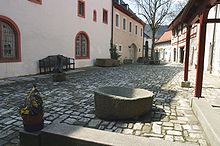Fichtelgebirgsmuseum
The Fichtelgebirgsmuseum is a regional museum in Wunsiedel , formerly the "capital" of the Sechsämterland and today the district town in the Fichtelgebirge.
museum
The formerly respected trades such as pewter and potter were displaced by industry as early as the 19th century. Therefore, as early as 1907, the desire arose to keep the old skills. The museum was realized by the Fichtelgebirgsverein . Since 1964, it is located in a wing of the company founded in the 15th century Sigmund When - Hospital (which is the task of a hospital filled). In the 1980s, further hospital buildings were converted and added to the museum, and the last two buildings were opened in 2004. In the first newly added building, the departments “Blue Dyeing / Blueprint”, “Children's Worlds / Play Worlds” and a museum depot that is accessible to visitors have been set up. The second new building houses the museum library as well as workshops and function rooms. The museum now has more than 2500 m² of exhibition space in nine buildings.
The prehistory , geology , mineralogy and mining departments are located in the north wing . The focus is on a mineral collection with approx. 2000 individual pieces, which mainly come from the Fichtel Mountains , the northern Upper Palatinate Forest , the Münchberger Gneissasse and the Franconian Forest . The regional and cultural history departments are located in the south wing. Particularly noteworthy is the furniture collection, which mainly includes painted furniture from the 18th and 19th centuries from the Fichtel Mountains. Documentation provides information about the author Jean Paul (1763–1825) and the political assassin Karl Ludwig Sand (1795–1820) - both were born in Wunsiedel .
workshops
There are three workshops on the ground floor of the north wing : a forge , a pottery and a pewter foundry . Visitors can get an idea of the formerly important craft trades here.
Blacksmith and tin caster offer demonstrations on request or for special events, often e.g. B. to the Wunsiedler Brunnenfest . In the pottery, on the other hand, from Tuesday to Friday mornings, art ceramicist Fred Zimmermann regularly produces goods based on historical models. He also runs a pottery farm in Höchstädt in the Fichtel Mountains .
literature
- Oswald A. Erich: The German museums with special consideration of the local museums. Vol. 1: The museums in Bavaria . Berlin 1939.
- Dietmar Herrmann: From the 100-year history of the Fichtelgebirgsmuseum . In: The Seven Star . 2008. p. 3.
- Josef Maria Ritz: The Fichtelgebirgsmuseum in Wunsiedel . In: The Seven Star . Issue 2 (1928). Pp. 1-12.
- Bernhard Hermann Röttger : District of Wunsiedel and urban district of Marktredwitz . The Art Monuments of Bavaria , VIII. Administrative Region Upper Franconia, Volume 1 . Munich 1954. ISBN 3-486-41941-2 . Pp. 577-591.
- Zweckverband Fichtelgebirgsmuseum (ed.): Accompanying book to the departments . Wunsiedel 1998.
Movies
Documentary "Schatztruhe Spital" about the Fichtelgebirgsmuseum, 15 min., 3 sat
Web links
- Fichtelgebirgsmuseum Wunsiedel
- Fichtelgebirgsverein
- http://www.bayern-fichtelgebirge.de/hochebene/18.htm?18
Coordinates: 50 ° 2 ′ 20.1 ″ N , 12 ° 0 ′ 11.9 ″ E



